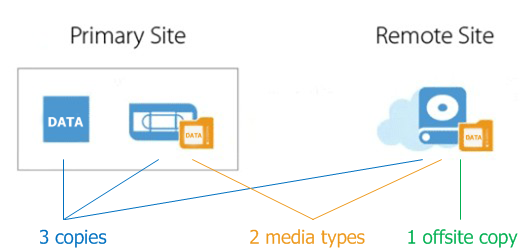5 Thing Note important principles in data Backup Hybrid Backup Model
Like it or not, backing up data is something that every IT person needs to do. As the IT manager of the business, if you do not guarantee this important work, you are betting the company and your own work on the game of chance. You should remember In IT, any job can be handled; except for one thing.
Backup Hybrid Backup model
Comprehensive backup solution and combined performance Local Backup + Offsite Backup + Cloud Backup. Not only does it help to backup offsite automatically and safely, zBackup also provides us with virtual servers for DR testing for ERP Dynamics AX systems. With this backup system, we can periodically conduct the rehearsal of the AX system recovery situation based on each probable incident scenario.
- Backup Local to NAS, External HDD
- Offsite backup to zBackup system
- Backup Cloud to Google Drive, OneDrive
- Support AD, SQL, Exchange, Oracle, MySQL
- 256-bit AES and SSL encryption
- Provide Google Drive account, NAS / External HDD device

The following article clarifies 5 basic (and important) principles to help you backup your data securely, recoverable when data loss occurs.
# 1 - Obey the backup rule 3-2-1
Thanks to Peter Krogh for suggesting a 3-2-1 rule in backups (interestingly, Peter Krogh is a photographer, not an IT citizen ^^). 3-2-1 backup rule recommends:
Each data file has at least 3 copies (1 original + 2 backups)
Save on at least 2 different storage devices
Have at least 1 offsite backup
If you follow the rules above, you can be assured of the security of the data.
An example of a backup that complies with rule 3-2-1: Your company's File Server data is backed up simultaneously to the External HDD and zBackup's Cloud Backup service. At this time, you have:
3 copies of data (1 original in File Server + 1 backup in External HDD + 1 backup to zBackup storage system)
2 different devices / storage areas for 2 backups are External HDD and zBackup storage system
1 backup is stored offsite on zBackup system (away from your office)
# 2 - Make no mistake between Replication and Backup
In some ways, replication has the meaning of backup. But it is an imperfect meaning. With replication, when the original data changes, this change is almost immediately updated to the replication. If that change is a logical error within data? Of course this error immediately "spreads" to the replication. As a result, you have both versions have the same error: the original is corrupted, the replication is also corrupted, so it is not helpful for you. In this situation, only a backup copy (before the above error occurs) can help you recover. That is the difference that backup brings compared to replication.

In fact, replication is increasingly important in the enterprise's Disaster Recovery strategy. Replication is an extremely effective solution that helps in situations of physical problems such as HDD errors, fires, etc. Replication helps to minimize RPO and RTO many times when encountering these problems. But the logical error that occurs within the data is a major problem with replication. Therefore, replication should not be a backup alternative. A backup strategy combining both is best.
# 3 - Automation
Nothing is more dull and boring than backing up data. Hardly any IT people love this job (and certainly do not like recovery work, because that means the problem has occurred, very risky and pressure). This is a job that is hard to see when the system is operating normally. Therefore, backing up if it has to be done manually, depending on the awareness, responsibility, memory of IT people is extremely dangerous.
Automate all possible operations with backup tools: backup scheduling, data encryption, version management, offsite mirroring, etc. Even there are software to support automatic recovery process. recovery to check backup data. Of course, this principle does not encourage you to give 100% to the software and forget about this task. Periodically, check to make sure no errors have occurred (see also Principle # 5 - Testing).
# 4 - Data encryption
You think the IT department is actively managing backup data completely, so what should encryption do? Not sure. You don't know what happens when your device needs to be serviced one day, or if there is an unknown leak during offsite storage (probably at your home).
Nothing is for sure. Except for one thing: Encrypt data when backing up.
# 5 - Testing, testing & testing
Backup and restore are two different sides of the same story. Backing up does not mean restoring (obviously.). There are many stories about IT people every day trying to make a successful backup but when it comes to recovering, it can detect corrupted data. Of course, it was too late.
Conducting regular testing is the only way to trust you to recover when needed. If this is not possible monthly, you should at least make a quarterly arrangement. Testing not only helps you to test data, ensure resilience; but also help you master the recovery steps. So that when the problem suddenly happens, you know what steps to take to recover the system in the fastest time (the lower the RTO, the better).
- Choose the best configuration management tool for your business
- Essentials on Hitachi Content Platform (HCP) Data Protection and Security
- When used Software as a Security nightmare: The risks of collaboration in the cloud
- About this webinar | Features and instructions for using Webinar
- How to use Webinar in business | Webinar Story 2019
Operate and exploit advertising by iCOMM Vietnam Media and Technology Joint Stock Company.
Adress: 99 Nguyen Tat Thanh, To 2, Khu 6, Thi tran Tan Phu, Tan Phu, Dong Nai.
Email: [email protected] | Tel: (+84) 984654960
Editor in chief: Tran Nha Phuong
Company: Lucie Guillot (Nha Phuong Tran)




